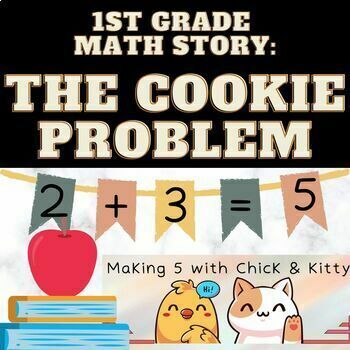1st Grade Eureka Math Companion Story: The Cookie Problem - Making 5
- Google Slides™

Also included in
- Involve the minds of your 1st graders with this cute story of two friends, Chick and Kitty, as they discover how difficult it can be to split 5 cookies between them!The Cookie Problem is a story about friends, adding up to 5 and 6, and sharing. Students not only get the visuals of seeing each characPrice $4.00Original Price $7.00Save $3.00
Description
Involve the minds of your 1st graders with this cute story of two friends, Chick and Kitty, as they discover how difficult it can be to split 5 cookies between them!
The Cookie Problem is a story about two friends who make 5 cookies, and then discuss how to split them.
Should Chick get 5 cookies? That would mean that Kitty wouldn't get any!
Should Chick get 4 cookies? Then Kitty would only get 1!
Students not only get the visuals of seeing each character with the cookies on their side of the plate, there is also an addition sentence at the bottom of each slide that shows the mathematical relation.
For example, if Chick gets 2 cookies, Kitty would have 3. The addition sentence on this slide would show 2+3=5.
Eureka Math can be so dense for 1st graders. Concept development can leave many students disengaged, especially our younger mathematicians.
Use this quick story to pique their interest and get them involved!
I usually teach this lesson during Eureka Math, Module 1 (Grade 1) before teaching "Making 6," which is lesson 4 in the series.



